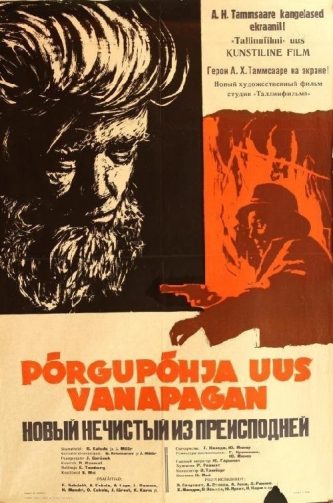 1964’s PÕRGUPÕHJA UUS VANAPAGAN, a.k.a. DEVIL WITH A FALSE PASSPORT, DEVIL ON EARTH, THE NEW DEVIL OF HELLSBOTTOM or (as the film is most commonly known) THE MISADVENTURES OF THE NEW SATAN, is all-but completely unknown in the English speaking world but widely considered a classic of Estonian cinema. The first of two film adaptations of an acclaimed 1939 novel by A.H. Tammsaare, it’s an unexpectedly thoughtful and sensitive fantasy (and so diametrically opposed to the second adaptation of Tammsaare’s novel, a 1977 telefilm that’s as wild and excessive as anyone could possibly desire).
1964’s PÕRGUPÕHJA UUS VANAPAGAN, a.k.a. DEVIL WITH A FALSE PASSPORT, DEVIL ON EARTH, THE NEW DEVIL OF HELLSBOTTOM or (as the film is most commonly known) THE MISADVENTURES OF THE NEW SATAN, is all-but completely unknown in the English speaking world but widely considered a classic of Estonian cinema. The first of two film adaptations of an acclaimed 1939 novel by A.H. Tammsaare, it’s an unexpectedly thoughtful and sensitive fantasy (and so diametrically opposed to the second adaptation of Tammsaare’s novel, a 1977 telefilm that’s as wild and excessive as anyone could possibly desire).
The setting is the rural farming community of Hellsbottom, where a childless old man dies on All Souls’ Day. This somehow causes God to doubt whether mankind is still capable of achieving salvation, a fact the Devil learns upon showing up at the door of Heaven to collect his share of souls. Told by St. Peter that God has elected to close down the afterlife—including Hell—altogether, the Devil agrees to live as a human on the mortal plain, and if he can achieve salvation there God will reverse his decree.
Thus the Devil, in the guise of a frizzy-haired (to hide his horns) peasant named Jürkan, moves into Hellsbottom together with his wife, who calls herself Lisete. Their settling in is quite rocky, with Jürkan finding Lisete screwing around with a local farmhand, to which Jürkan retaliates by burning down the stud’s house with him in it.
The farmhand’s place is taken by a woman named Juula, with whom Jürkan commences an affair that leaves her pregnant with twins. Upon learning of this Lisete succumbs to despair and heads back to Hell, leaving Jürkan to marry Juula.
As Jürkan and Juula’s twin daughters grow up horns sprout from the sides of their heads, showing their true natures. Worse, Jürkan gets involved with a slimy businessman who screws him over in ways even he—the Devil—never thought possible. He also has to deal with human grief after one of his now teenaged children dies, followed by Juula.
This leaves Jürkan alone with his surviving twin daughter, who he teaches to lie and cheat like the authority figures surrounding him. It would seem that the “New Satan’s” efforts are doomed to failure, and he eventually dies, with the fate of mankind left unexplained.
The filmmaking here, by directors Grigori Kromanov and Jüri Müür, is competent but largely undistinguished. The opening scenes, set in a clichéd depiction of Heaven—a vast expanse with mist on the ground—are uninspiring from a photographic and conceptual standpoint, although the remainder of the film, set in a rustic forest visualized via robust black and white imagery, is a bit stronger.
The film’s power, I’d argue, emerges largely from its source material, which imparts a powerfully emphatic sense of sadness and injustice in a narrative that’s largely metaphoric in nature, and also the lead performance of Elmar Salulaht. The burly and imposing Salulaht has a commanding screen presence, and is never less than fully convincing as the Devil in human guise—a Devil that emerges as both wily and deeply tragic.
Vital Statistics
THE MISADVENTURES OF THE NEW SATAN (PÕRGUPÕHJA UUS VANAPAGAN
Tallinnfilm
Directors: Grigori Kromanov, Jüri Müür
Producer: Veronika Bobossova
Screenplay: Jüri Müür, Gennadi Kaleda
(Based on a novel by Anton H. Tammsaare)
Cinematography: Jüri Garsnek
Editing: Ludmilla Rozenthal
Cast: Elmar Salulaht, Ants Eskola, Astrid Lepa, Leida Rammo, Heino Mandri, Olev Eskola, Karrel Karm, Jüri Järvet, Jaan Saul, Heili Sild, Lea Unt, Oskar Liligand, Hugo Laur, Ervin Abel, Einari Koppel, Ants Jõgi
